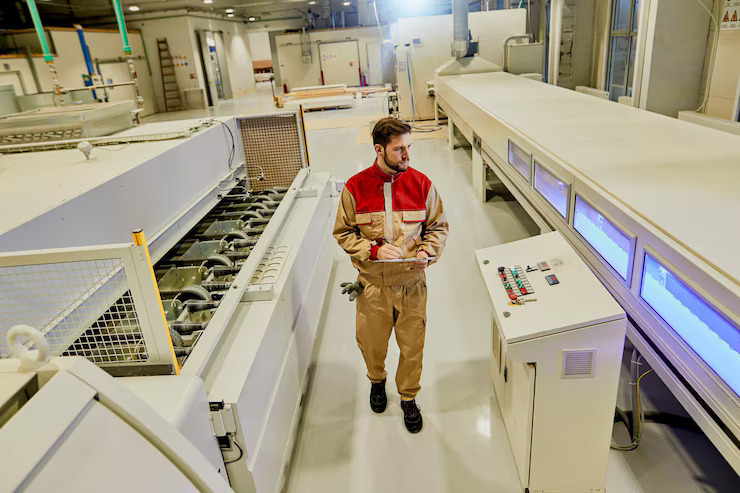With the increasing demand for concrete and raw materials in construction, concrete producers can’t afford downtime. Conventional methods are no longer cutting it, and smart maintenance is becoming essential.
The days of wait-and-react are over. Nowadays, concrete plant operators require prevention-oriented solutions to keep machines going, beat failures, drive down costs, and comply with regulations. From predictive maintenance systems to logs and asset monitoring tools, the concrete sector is reshaping its approach to enhance reliability and performance.
In this blog, we’ll explore how smart maintenance can benefit concrete producers, what tools and technologies are driving this change, and how to implement a successful strategy aligned to a construction company’s unique needs.
What is Smart Maintenance?
As technology evolves over time, maintenance software and systems have been updated to provide a more resilient, efficient, and automatic experience. This experience is all about minimizing equipment downtime and having a more controlled view of your inventory, assets, and other maintenance activities. It encompasses a variety of AI sensors, models, and machine learning (ML) tools to continuously monitor the condition of equipment and predict when maintenance should be performed.
In a concrete plant, smart maintenance is not merely about repairing faulty mixers or conveyors. It is about having a connected system that tracks equipment health, examines performance trends, and automatically schedules service activity. This way, production is always smooth, resources are utilized effectively, and upcoming issues are resolved before they cause operations to be interrupted.
Key benefits of smart maintenance include:
- Predicting issues before they happen means fewer unexpected breakdowns.
- You can save on unnecessary parts and labor by fixing equipment only when necessary.
- Continuous monitoring helps avoid severe wear and tear.
- Systems can log and track all maintenance activities, making audits simpler and more accurate.
Why is Predictive Maintenance Important in the Concrete Industry?
One of the most useful tools of smart maintenance is predictive maintenance. It is a system that employs real-time insights to anticipate equipment failure and perform maintenance exactly in time. Predictive maintenance has special merit for the concrete industry, in which production delays mean that the materials used are wasted, there will be a delay on the project, and by proxy, costs will increase. Critical equipment like mixers, conveyors, and batching plant equipment must function under tough conditions. Predictive maintenance relies on data (i.e., temperature, vibration, pressure) gathered by sensors attached to the equipment to monitor for unusual trends that signal future risk. The data is subsequently analyzed using sophisticated algorithms to foresee failures before they happen.
Having a smart predictive maintenance system installed in your maintenance operations means that you can:
- Have real-time monitoring accessibility through sensors that continuously collect performance data.
- Use software powered by machine learning to analyze trends and detect deviations.
- Get notifications when a potential failure is detected.
- Perform optimized maintenance scheduling on time.
How Smart Maintenance Helped a Concrete Company
A mid-sized concrete plant was experiencing continuous equipment maintenance failures, especially batch mixers and conveyor belts. This downtime caused production delays, increased labor costs, and missed delivery schedules, which ultimately impacted the plant’s reputation and profitability.
In response to these challenges, the plant implemented a predictive maintenance system as part of an overall maintenance strategy. This included:
- Placing IoT sensors on strategic pieces of equipment to monitor parameters such as temperature, vibration, and motor efficiency in real time.
- Connecting the sensors to a software maintenance platform that had automated notifications and kept digital maintenance records for every service intervention.
- Using asset tracking and manufacturing inventory control software to guarantee essential spare parts availability and maximize resource allocation.
Ultimately, the installation of the predictive maintenance system enabled them to achieve:
- 20% equipment availability boost in the first six months.
- Emergency repair expenditures fell by 30%.
- Maintenance activities were carried out during off-peak hours.
- Compliance with regulations was enhanced by automated, computerized documentation.
Smart Maintenance Implementation: A Step-by-Step Guide
It’s time to upgrade to a smarter, more efficient maintenance strategy for your concrete production operations. To help you get started, we’ve outlined a clear, step-by-step implementation guide to make the transition easy.
1. Evaluate Current Maintenance Practices
To move forward with an efficient maintenance plan, you must acknowledge your current position. It helps to identify inefficiencies in your existing systems that are causing routine breakdowns, manual tracking practices, incomplete maintenance logs, and compliance vulnerabilities.
You also need to determine loopholes in asset tracking, documentation, and scheduling. This will provide a starting point to ground your future improvements.
2. Implement IoT and Analytics
IoT sensors are a foundational piece of predictive maintenance. You need to place these sensors on critical assets such as mixers, conveyors, and batching systems. Once done, you can access real-time vibration, temperature, and motor condition readings.
Always remember to connect these sensors to a central software maintenance program based on analytics that can predict failures and send automated notifications.
3. Digitize Maintenance Logs
No one can handle the clutter of paper-based maintenance logs, so replacing them with digital data is convenient. Cloud storage improves traceability, helps make auditing easier, and ensures compliance with regulatory laws.
Looking for equipment history, past errors, and service schedules manually is highly time-consuming. Once you have a digital system, you must type in the relevant keywords to find all the data related to specific equipment.
4. Automate Inventory and Resource Management
Modern maintenance is not restricted to predictive maintenance. Implementing manufacturing inventory management software helps manage spare parts, lubricants, and consumables. Benefits include automated reordering, elimination of stockouts, and optimal inventory levels.
5. Train Staff on New Systems
No matter how updated and smart a maintenance system you employ, if your staff isn’t trained to use it, you may not be able to maximize its potential. So, you must invest in training programs to make your maintenance teams use smart technologies, well, smartly.
It is also essential to enable confidence in your employees to use asset tracking tools, log data into new systems, and interpret predictive analytics.
6. Monitor, Review, and Improve
Consistency is important in everything, and the same goes for maintenance systems.
You need to utilize your software maintenance dashboard to track equipment performance and team activity continually. Make sure to periodically review your maintenance logs and performance KPIs to look for additional opportunities to optimize.
FAQs
What is smart maintenance?
Smart maintenance is a fusion of standardized maintenance methods with technologies such as IoT sensors and artificial intelligence. Proactively managing asset maintenance helps reduce downtimes, errors, and risks.
What is concrete maintenance?
Concrete maintenance involves frequent inspections, cleaning, and repairs to prevent the degradation of concrete structures for safety and durability.
Why is predictive maintenance important in the concrete industry?
Predictive maintenance enables the early identification of possible equipment breakdowns, minimizes surprise downtime, saves money, and maximizes continuous production in concrete facilities.
Final Thoughts
Downtime and equipment failures aren’t options in the competitive world of concrete production—every minute counts. To stay ahead, adopting a smart, automated maintenance strategy is essential. That’s where a CMMS (Computerized Maintenance Management System) comes in.
A modern, mobile-friendly platform like Azzier streamlines the entire process—connecting IoT data, digital logs, and real-time reporting in one intelligent, easy-to-use system.
If you’re still relying on outdated maintenance methods, now’s the time to make a change. Optimize your operations and take control with a CMMS built for today’s industrial demands.






















































